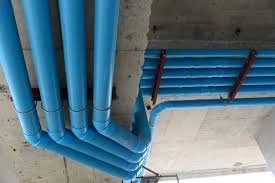Introduction
PVC (PVC Pipe DIN), or Polyvinyl Chloride, is a versatile plastic used in countless applications from construction to medical supplies. Yet, its environmental impact has become a significant concern. As we move towards more sustainable practices, it’s crucial to examine both the challenges and opportunities in making PVC more eco-friendly.
What is PVC?
Definition and Composition
PVC is a synthetic polymer made from vinyl chloride monomers. It’s known for its durability, flexibility, and cost-effectiveness, which makes it a popular choice for various products. The polymer can be made rigid or flexible by adding different additives, influencing its use in a wide range of applications.
Common Uses of PVC
PVC’s versatility extends across several sectors:
- Construction: Pipes, window frames, and flooring
- Healthcare: Medical tubing and IV bags
- Consumer Goods: Toys, clothing, and packaging
The Environmental Impact of PVC Pipe
Manufacturing Process and Its Environmental Footprint
The production of PVC involves the polymerization of vinyl chloride, which releases dioxins and other pollutants into the environment. Additionally, the extraction of raw materials and the energy required for manufacturing contribute significantly to its carbon footprint.
Issues Related to PVC Waste
PVC is not biodegradable and can persist in landfills for hundreds of years. When exposed to sunlight or heat, it can release harmful chemicals, further exacerbating environmental pollution.
Toxicity and Health Concerns
Certain additives used in PVC DIN, such as phthalates and lead, can leach out over time, posing health risks. This toxicity raises concerns about the safety of PVC products, especially those in direct contact with humans, like medical devices or toys.
Challenges in PVC Pipe Sustainability
Resource Extraction and Energy Consumption
PVC production requires substantial energy and resources. The extraction and processing of raw materials like chlorine and ethylene are resource-intensive and contribute to environmental degradation.
Chemical Additives and Their Environmental Effects
PVC products often contain additives to enhance performance, but these can be harmful. For example, stabilizers and plasticizers might leach out, contributing to pollution and health risks.
Waste Management and Recycling Difficulties
Recycling PVC is challenging due to its complex composition and the presence of additives. Although there are recycling programs, the process is often not economically viable, leading to limited recycling rates.
Opportunities for Sustainable PVC Pipe
Innovations in PVC Production
Emerging technologies are addressing some of the sustainability issues in PVC production. For instance, new methods are being developed to reduce energy consumption and lower emissions during manufacturing.
Advances in Recycling Technologies
Recent advancements in recycling technologies are making it easier to process PVC waste. Chemical recycling, which breaks down PVC Pipe DIN into its monomers for reuse, shows promise for improving recycling rates.
Use of Bio-based and Eco-friendly Additives
The development of bio-based additives provides a greener alternative to traditional chemicals. These can help reduce the environmental impact of PVC products without compromising their performance.

Case Studies and Real-World Applications
Examples of Sustainable PVC Projects
Several projects showcase the potential for sustainable PVC DIN. For instance, companies are using recycled PVC in new products and developing closed-loop systems to minimize waste.
Successful Recycling Programs and Initiatives
Initiatives like the VinylPlus program in Europe focus on improving PVC Pipe DIN recycling rates and promoting sustainability within the industry. These programs illustrate the positive impact of collaborative efforts.
Regulatory and Industry Standards
Overview of Global Regulations on PVC
Governments around the world are implementing regulations to control the environmental impact of PVC. These include restrictions on harmful additives and requirements for proper disposal and recycling.
Industry Efforts Towards Sustainability
The PVC industry is working towards sustainability through various initiatives, such as reducing carbon footprints and investing in cleaner technologies. Industry standards and certifications are evolving to support these goals.
Future Prospects and Trends
Emerging Technologies in PVC Production
Future trends in PVC production include the development of more sustainable manufacturing processes and the use of renewable resources. Innovations like green chemistry could revolutionize the way PVC is produced and used.
Predictions for the Future of Sustainable PVC
Looking ahead, the push for sustainability will likely drive further advancements in PVC technology. Greater emphasis on recycling, reduced use of harmful additives, and more efficient production methods are expected to shape the future of PVC.
Conclusion
The journey towards sustainable PVC is fraught with challenges but also offers significant opportunities. By embracing innovations in production and recycling, and adhering to stricter regulations, the PVC industry can reduce its environmental footprint. The future of PVC DIN sustainability hinges on continued efforts from manufacturers, regulators, and consumers alike.
FAQs
What are the main environmental issues with PVC?
PVC’s environmental issues include its non-biodegradability, the toxic additives used in its production, and the pollution generated during manufacturing and disposal.
How can PVC recycling be improved?
Improving PVC Pipe recycling involves advancing recycling technologies, such as chemical recycling, and increasing the economic viability of recycling processes.
Are there any eco-friendly alternatives to PVC?
Yes, there are eco-friendly alternatives such as bio-based plastics and other polymers with lower environmental impacts.
What role do regulations play in PVC sustainability?
Regulations help control the environmental impact of PVC by setting standards for production, use, and disposal, and by promoting the development of sustainable practices.
How can consumers contribute to PVC sustainability?
Consumers can contribute by choosing products made from recycled or sustainable materials, supporting companies with eco-friendly practices, and properly disposing of PVC DIN products.